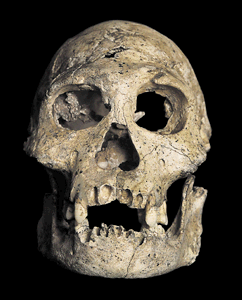Fossil Skull Suggests Pruning Needed for Human Family Tree
Monday, October 21st, 2013October 21, 2013
A 1.8-million-year-old fossil skull will almost certainly force scientists to trim some branches from the evolutionary “family tree” that eventually led to modern humans, paleoanthropologist David Lordkipanidze of the Georgian National Museum in Tbilisi suggested last week. The fossil, known simply as Skull 5, is one of several nearly complete fossil skulls discovered by Lordkipanidze and his team since 1991 at Dmanisi, a fossil site at the eastern end of the Black Sea in the Caucasus Mountains, about 50 miles (85 kilometers) southwest of Tbilisi. The skulls are among the most ancient fossils of human beings found outside of Africa, the cradle of humanity.
The Dmanisi fossil skulls have large browridges and projecting faces that lack chins. Scientists calculate that the skulls held brains that were about half the size of modern human brains. The skulls resemble those of early human ancestors found at fossil sites of about the same age in East Africa. Many scientists divide these ancestors into three species–Homo habilis, Homo rudolfensis, and Homo erectus. Some scientists argue that even more species of early humans existed nearly 2 million years ago, suggesting the human fossil “family tree” was more like a bush with many side branches.

A 1.8-million-year-old human fossil skull from Dmanisi, Republic of Georgia, displays thick skull bones; a low, sloping forehead; and a flat face. The species also had a thick ridge of bone above the eyes, called a browridge. (Mauricio Anton © 2002 National Geographic Society)
Lordkipanidze noted that Skull 5 and four others excavated at Dmanisi almost certainly represent a single population that lived in the same location at the same time. The skulls thus provide an unprecedented opportunity to measure the differences within a group of ancient humans. He found that the skulls showed remarkable differences in such features as the length of the jaw or thickness of the browridges. But, he said, the differences were no greater than those between any five modern people. All people alive today are members of single species, Homo sapiens.
Other anthropologists pointed out that if the five skulls from Dmanisi had been discovered at different sites in Africa, their physical differences could have led scientists to assign the skulls to different human species. The long-established habit of defining new species based on physical variation means that Skull 5 may have been classified as an entirely new human species.
Lordkipanidze and his colleague now theorize that there was only a single human species in Africa 1.8 million years ago and that same species is also represented at Dmanisi. They do not suggest what species that may be, but they recognize it as a member of our own genus, Homo. They argue that one or more of the early Homo species from Africa may need to be pruned from the human family tree.
Additional World Book articles:
- Archaeology
- Prehistoric people
- Stone Age
- Anthropology (2002) (a Back in Time article)
- Anthropology (2007) (a Back in Time article)


